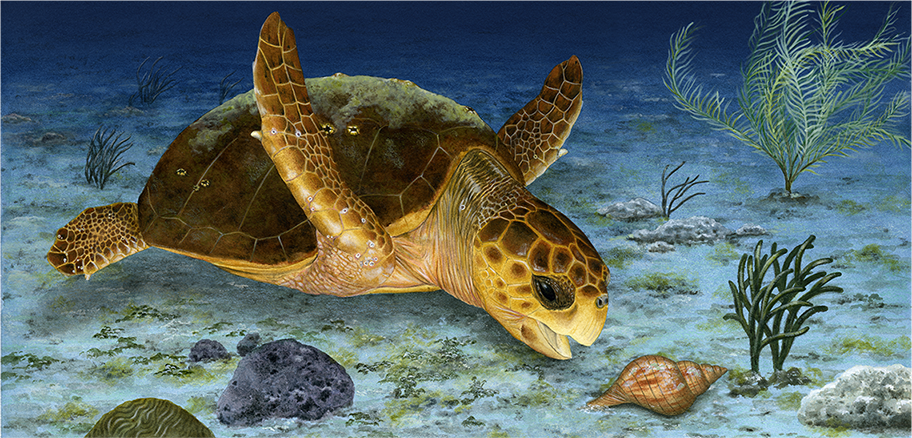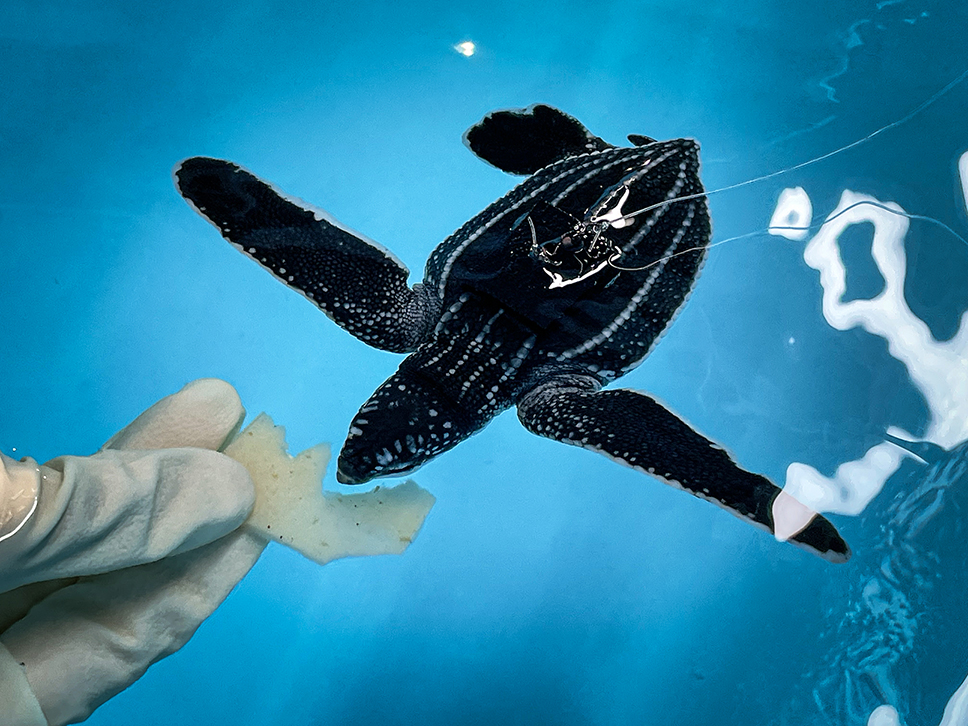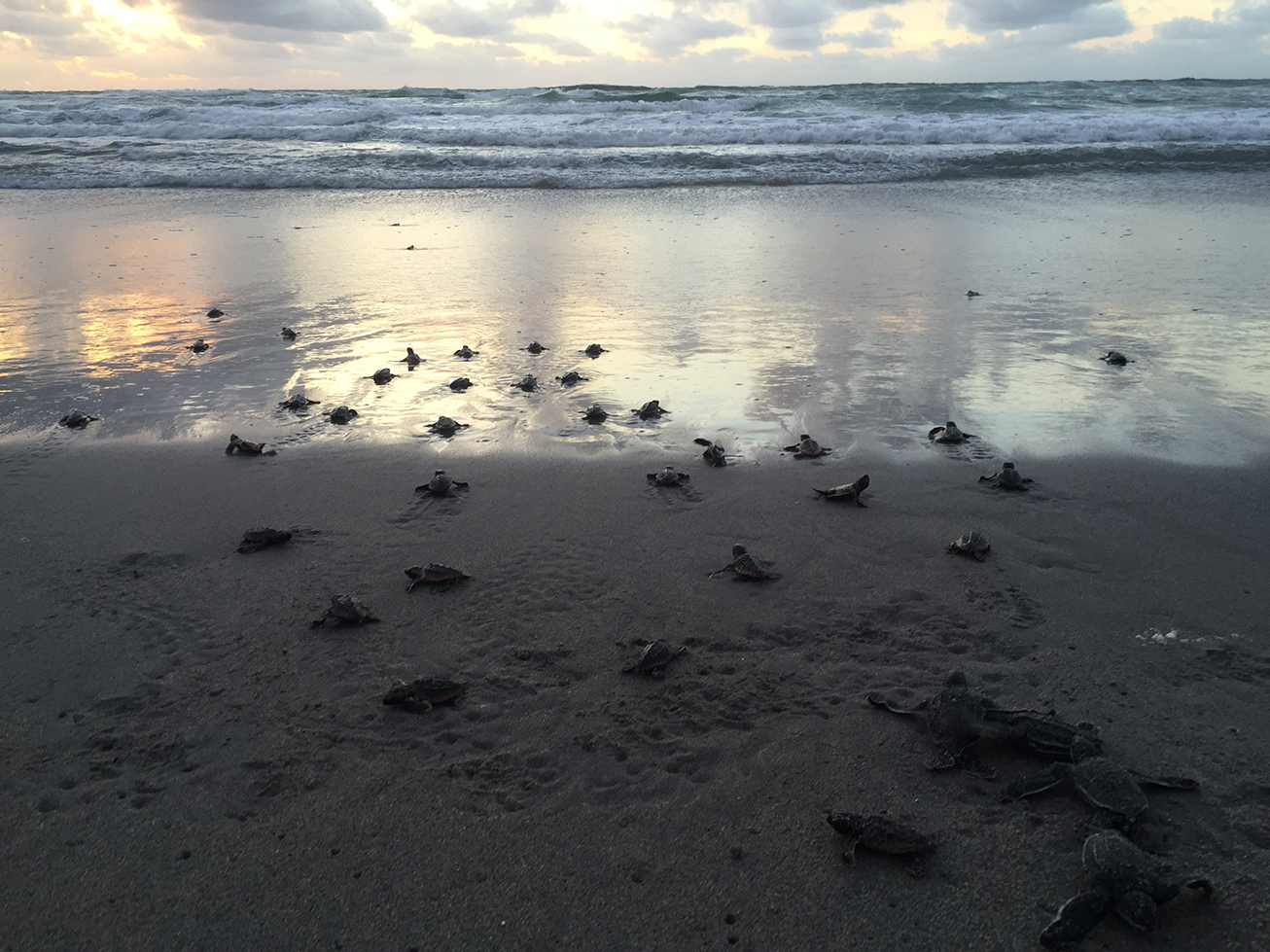
Author: Sam Trail
Date: November 26, 2023
Many of us spent the last week heading home for the holidays. Perhaps some of you are still in a chaos-induced stupor from all the food, family, and travel. As I sit in the airport surrounded by others ending their holiday escapades, I wonder: “What is a sea turtle’s take on Thanksgiving break?”
Food
A typical Thanksgiving feast often includes mashed potatoes, stuffing, green beans, and the sleep-inducing star of the show: turkey smothered in gravy. Then, after a few hours of digesting, it’s time for pie! What would be on a sea turtle’s plate?
The three species we care for at the FAU Marine Lab would all answer this question a little differently. Lobster dinner, anyone? As adults, loggerheads are considered generalists, but their large head and powerful jaws allow them to eat shelled animals like lobsters, crabs, and even conchs that live on coral reefs and seagrass beds. This could add up to an expensive holiday meal! Little loggerheads, on the other hand, opportunistically feed on small insects that get blown way offshore and a variety of marine invertebrates living in floating algal mats of Sargassum. So this “kids table” isn’t as picky as the one at my Thanksgiving celebration. As their name suggests, adult green sea turtles are vegetarians, primarily feeding on seagrasses and algae. Someone has to eat that salad your second cousin brought! However, like loggerheads, young green turtles are not picky and also consume animal prey. Lastly, leatherbacks are specialists throughout their entire lives, foraging on gelatinous prey such as salps and jellyfish. These are not like that canned cranberry sauce that just a few at the Thanksgiving table covet.
It can be difficult to maintain all of these diets in captivity, so at the FAU Marine Lab, we make all of our turtle food “in house” to fulfill the same caloric needs our small turtles would require out in the wild. There’s nothing like home cooking!

Family
There is the family you are born with and the family you choose. I am grateful that my Thanksgiving celebration was filled with both, but what does a “family gathering” look like for a sea turtle?
In the nest, a sea turtle embryo can be surrounded by up to 120 siblings! All the eggs in a nest are laid by the same mom but often, each nest has a few different dads. Additionally, the environment around the nest determines if those siblings become brothers or sisters. The phrase ‘Hot Chicks, Cool Dudes’ reminds us that hot nests produce a preponderance of females while cooler nests produce mostly males. But with so many eggs in each nest, it should come as no surprise that different portions of the nest are often warmer or cooler than other portions (the middle versus the periphery or the top versus the bottom). That means a single nest often produces a mixture of males and females.
When it is time to head to the ocean, hatchlings inside the nest emerge on the beach and scurry toward the water. By this time, Mom has been gone for months and so the hatchlings have no adult supervision; they disperse individually based upon their own suspicions of where important ocean currents, leading to essential nursery areas, are located. As they get older, young sea turtles select more permanent foraging grounds. This metaphorical “dinner table” might be shared with turtles from the same nesting beach but often those turtles, again based upon their own ideas, end up in vastly different foraging grounds shared with turtles from vastly different nesting beaches. So, in turtles as well as in our homes, Thanksgiving results in a shared table.

Travel
Planes, trains, and automobiles dominate our frenzied travels in the days before and after Thanksgiving. Some travel far distances and others drive their crockpot just down the street for the feasting festivities. How far do turtles travel and what mode of transportation do they use?
Sea turtles migrate greater distances than any other reptile on the planet, sometimes thousands of miles and across entire ocean basins. These great migrations take sea turtles from nesting grounds to foraging grounds and back again. Generally, adult turtles travel these vast distances once every two to three years, but that can happen more or less frequently based upon the local food supply.
A prolonged swimming journey requires lots of energy! Sea turtle swimming is powered by their large front flippers (similar in shape to the plane’s wings I see out my window at the airport terminal). However, as opposed to airplane wings, sea turtle flippers move in an elaborate path to achieve ‘aquatic flight.’ This sea turtle specific powerstroke is used by all species and life stages to get most rapidly and efficiently from point A to B.
So while sea turtles may not experience Thanksgiving like we do, they know a thing or two about food, family, and travel. We are thankful for the opportunity to study them every day at the FAU Marine Lab!